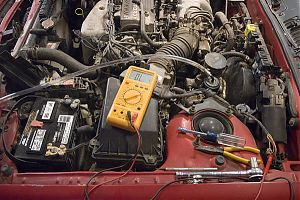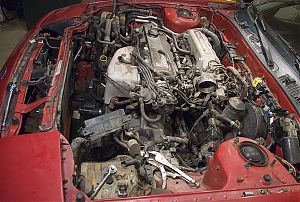Day One: Toxic Avenger · 15 September 05

In the middle of working on Eve last night, with oil sluggishly draining into a container under the car, another vat glowing sickly green below the radiator, and gas fumes wafting through the air, I started to think (or hallucinate) that maybe Eve should have an alter ego:
Toxic Avenger!
Too bad, it’s already taken.
Before we jump into what I do for fun on a Wednesday night, let’s talk about tools. Sometimes I forget that not everyone who reads this and considers doing their own conversion is a complete tool head or mechanical wizard.
It helps to know a bit about what you are dissecting but there are all kinds of resources you can tap into (locally and on the net). Machine shops, welders, auto mechanics, electronics geeks…most of them are more than happy to hear about your project and pitch in. Don’t let inexperience stop you from trying, just realize your limits and ask for help.
You probably aren’t going to believe this, but your gas car is far more complicated than an EV. A gas vehicle has more electronics, sensors, tubes, and wires than any EV. Think about it: today’s cars are a marriage of mechanics and electronics, full of chemicals, bristling with sensors, loaded up with heat management gear, and completely monitored and controlled by one or more computers.
An EV has only a handful of components: a few relays, electric motor, controller, batteries, wires, a vacuum pump, and a few connecting and protecting components. No smog control, no gas pumps, no fluid reservoirs, no air ducts, and so on. Very simple in comparison.
Here’s Eve’s engine compartment at the start of last night.
Tool wise you’ll need a metric socket set, even if it’s a US car, a couple screwdrivers (battery powered helps), a voltmeter (pictured), and a pair of pliers and wire cutters. A hacksaw might come in handy when you take the exhaust system apart. Most of the parts I removed from Eve so far were secured with a 10mm nut or bolt.
During the EV construction phase you’ll need a welder or to hire someone. You’ll also need wiring tools: strippers, crimpers, and shrink tubing and tape. And at some point a drill and metal cutting tools.
But first, time to change into our Toxic Avenger suit and rid this donor of its vile fluids…
I started the oil draining and then rummaged through the garage for a long hose to siphon the gas out. As a kid we got in trouble a few times for doing this very thing, but danged if I can work up the same interest in doing it now. Turns out the hose wasn’t long enough to snake all the way to the gas, plus the tank is really low to the ground, siphoning would be tough.
In a fit of genius (fume induced, I’m sure) right when I was wishing for a longer hose and maybe some sort of pump it hit me that the car already has all of this built in: fuel pump, duh!
In the photo above you can see the clear hose that I’ve attached to the top of the fuel filter, the other end is in the plastic gas container. There’s only one problem: the fuel pump doesn’t turn on until the engine is turned over or running.
I don’t have a manual w/schematic yet so it was time to improvise. Pulling the wires off the positive battery terminal you’ll usually find that there’s a really thick one and a skinnier one. The thick wire goes straight to the starter and I disconnected this from the battery. Now when I turn the key the fuel pump comes on, but the engine doesn’t spin and spin. It’s slow going but sure beats sucking down a lung full of the Middle East’s finest.
A couple minutes into the process there’s a noise and a cloud of smoke.
This is the part where I say “don’t try this at home” and “always have a fire extinguisher at hand.” Turns out the starter solenoid was still engaging and apparently isn’t designed for continuous use. Whoops! I found a couple of relays on the firewall (there are always relays) which were warm and disconnected them.
No more solenoid click, no more smoke.
After that I removed the battery, sealed off the fuel line hose (no drips or vapor), and started the radiator to draining. Got a nice dollop of greasy green radiator fluid on my toe at one point and spent the rest of the evening wishing I’d worn waterproof boots.
The photo shows the end of day one.
Parts removed so far:
- hood
- oil, gas, anti-freeze
- radiator
- battery
- fuel filter
- air intake system
- a couple fans
- a few brackets
- disconnected a half dozed engine sensors
- skin from the left index finger cuticle





This is the craziest thing, I just got the idea out of nowhere that it would be cool to convert either my 90 mazda b2200 truck or a little 323 I saw in the paper for 1000 dollars. Great job I just bought the build your own EV by that bob guy I can’t wait for it to arrive.
Go Tyson!
A B2200 would probably make a fine EV and would be the easiest to deal with the battery layout. Search the web for Chevy S10 conversions to find good examples.
LOL!! I was looking for the next day when I realized that the date on this page was the 15th of sept 05.
I am also interested in the conversion process, I will be following your progress closely, I have one question already though, is it better to have a lighter vehicled for this?
Hi Derek,
You bet, the lighter the better. Part of the decision for vehicle type is what you need it for: toting around a family of six, just yourself, or a load of bricks to a job site.
Then factor in how much range you need (which translates into size/# of batteries) and you start to get an idea of what kind of car can carry the weight of the batteries and still be efficient.